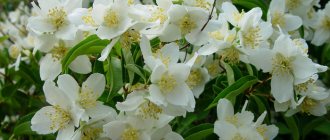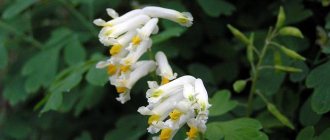Description of the Miss America peony
Miss America is a herbaceous peony. The hybrid grows quite quickly, single buds appear in the second year of life. It can remain in one place for 6 years, then it is necessary to rejuvenate the bush by dividing the rhizome.
Miss America is an early flowering culture, buds bloom alternately from mid-May to June
The duration of the cycle is 20 days. The flower lives for 5–6 days, then withers. After wilting, the flower stalks are cut off, and the plant, thanks to its openwork dense crown, remains decorative until autumn.
Description of the Miss America variety:
- The bush is dense, spreading, diameter – 60 cm, height – 75–85 cm;
- The stems are erect, hard-fibered, the surface is smooth, light brown.
- On the central shoot, 2–4 lateral peduncles are formed in the upper part. During the flowering period, the bush disintegrates, the stems droop quite low during rains.
- The leaf blades are attached to long petioles, 4–6 pieces each. The leaves are arranged alternately, the internodes are short, so the peony is quite densely leafy. The plates are lanceolate, green, glossy.
- The flowers are large, up to 25 cm in diameter, semi-double. The buds have a slight pink tint and turn white after blooming. The petals are rounded with smooth or feathery edges. The central part is open, consists of numerous stamens with bright lemon anthers.
- The aroma is weak or completely absent.
During flowering, Miss America does not hold its shape well; a garter to a fixing structure is recommended
Reproduction methods
The Miss America herbaceous peony is most often propagated by dividing the rhizomes. This is the most effective way to get a new, healthy and strong plant. Experienced gardeners also root cuttings cut from stems in the summer, or propagate by divisions from spring shoots. The method of dropping layering from formed stems is also used.
The easiest way is to divide the mother bush of adult peonies in the fall, at least 5-6 years old. Such seedlings take root well and begin to bloom profusely in the second or third year.
Flower buds form on the rhizome in early August. At the end of September, thick white roots are fully formed, in which the plants store nutrients. In the interval between these important processes for the peony, it is easiest to divide the rhizomes and select new planting material.
Advice! It is not recommended to divide peonies in the spring: the plant begins to develop green mass to the detriment of the root system.
Application in design
The variety is universal in use. The Miss America peony (pictured) is quite suitable for cutting. Peony is used in classic design plantings:
- create white gardens;
- included in mixborders, rock gardens;
- form borders and natural hedges;
- decorate lawns, ridges, flower beds, grow peonaria with a variety of flower colors;
- decorate recreation areas.
Peony harmonizes in the composition next to flowering and ornamental plants: hostas, roses, hydrangeas, irises, daffodils, dwarf thujas, spruces, and pines.
Important! The ground cover juniper will be an undesirable neighbor for the peony. Crops require different soil compositions, and ephedra often causes rust at Miss America.
Do not place next to aggressor plants:
- ground cover loosestrife;
- milkweed;
- ferns;
- bulbous ryegrass.
These species have a creeping root system. The crops grow quickly and displace the peony from the site.
Use Cases
Miss America is ideal both for planting alone and for arranging group, mixed compositions. It is suitable for placement in classic flower beds, ridges, and mixborders. Landscape designers use the delicate flower to create rock gardens and find a place for it in gardens and parks.
As companions for our heroine, it is better to select plants based on the shade of the inflorescences. The magnificent snow-white buds of Miss America will look incomparable in combination with flowers in scarlet and dark red wine tones. A wonderful example of such neighboring plants: carnation or heuchera. In addition, the freshness and whiteness of the inflorescences of the American perennial will be emphasized by sage, bellflower, irises and honeysuckle. You can combine peonies of this variety with coniferous and evergreen crops, with decorative foliage plants and fragrant herbs.
Wonderful buds suitable for cutting. They stand in water for a long time without losing their magnificent appearance. Florists include snow-white inflorescences on strong peduncles in various compositions.
Planting and care
Miss America is a light-loving plant. For the peony, a place is allocated in an area without shade and away from tall trees. It is also not recommended to plant the plant close to the wall of a building, especially a brick or stone one. Choose a well-drained area with light fertile soil.
Important! The composition of the soil should be neutral or slightly alkaline. Peony will not bloom on acidic soil.
Planting work can be carried out in spring or autumn (a month before frost). It is better to place seedlings and cuttings in the ground in the spring; they with weak roots may not survive the winter. It is best to divide the rhizomes of the Miss America variety in the fall. The root is removed from the soil, divided into parts, placed in peat and lowered into the basement.
In the spring, when the buds begin to grow, the Miss America peony is planted in open ground.
If the transplant is carried out immediately after digging, then the root is washed with water, allowed to dry, and divided into parts. To get a strong plant, one fragment must consist of 4 or more shoots, an intact neck and at least three buds.
A Miss America peony purchased from a nursery should look healthy, without signs of mold or mechanical damage. It is placed on the site along with soil from the container.
Miss America landing:
- A hole measuring 50*50 is dug two weeks before work. The bottom is covered with a drainage cushion and a fertile substrate consisting of a turf layer and compost, leaving 20 cm to the edge of the recess.
- The hole is filled with water so that the soil settles.
- Before planting the peony, prepare a fertile soil mixture and add complex mineral fertilizer to it.
- A lath is placed on the edges of the hole, the buds are deepened by 4–5 cm, the peony root is fixed to the lath and covered with substrate.
- Compact, water, cover the surface with ash.
Attention! If Miss America was planted at the end of the season, then the ground must be mulched.
Growing a flower, how to plant it correctly in open ground
In order for the peony to grow fully and ultimately bloom magnificently, it is necessary to initially plant correctly. Any disregard of cultural requirements can negatively affect the development of the bush.
Planting with root cuttings
Rose Miss Piggy - what kind of cut variety is it?
This method is considered the most common. Planting with root divisions guarantees the preservation of all the specific qualities of the peony.
It is necessary to choose a cutting with well-developed large and small roots. And also pay attention to the presence of recovery buds, from which shoots will subsequently grow. In this case, the root cutting should not be overdried and should not have cracks or signs of disease damage.
What time does boarding take place?
It is recommended to plant this herbaceous peony in the first half of April or postpone the procedure until September. The second option is preferable, since this allows the plant to put all its energy into rooting and not waste it on growing shoots.
Important! Autumn planting of peonies should be carried out at least 3-4 weeks before the onset of the first frost.
Selecting a location
This perennial prefers open sunny areas. Therefore, it cannot be planted near tall crops that will create shade for it.
This variety reacts negatively not only to a lack of moisture, but also to an excess of moisture in the soil. Therefore, when planting, it is necessary to take into account the level of groundwater in the area. It should be at least 1.2-1.5 m.
How to prepare the soil and flower for planting
The area for the peony should be prepared 2 weeks in advance. To do this, you need to dig it up to the depth of a shovel and carefully select the roots of the weeds. Then dig a hole 60 cm wide and deep. And lay broken bricks at the bottom as drainage.
The variety prefers to grow on loams
The remaining space should be filled with nutritious soil mixture. To do this, you need to mix the following components:
- peat - 1 hour;
- turf - 2 hours;
- sand - 1 hour;
- humus - 1 hour.
You also need to additionally add 40 g of superphosphate and 30 g of potassium sulfide.
Important! Nitrogen fertilizers cannot be applied during planting, as they have a depressing effect on the root system.
The peony root cutting also needs to be prepared. To do this, it is necessary to keep it in water 10-12 hours before planting in order to activate growth processes in tissues.
Step by step landing procedure
Peony planting is carried out according to the standard scheme. But it is important to observe some features.
Algorithm of actions:
- Place the cutting in the center of the planting hole so that the restoration buds are 3 cm below the soil level.
- Spread out the roots.
- Fill the voids with soil.
- Compact the surface.
- Water generously.
Important! The Miss America peony blooms in the third year after planting.
Planting with seeds (for selection)
This method is recommended to be used if you want to get completely new types of peony. After all, when planting seeds, the species qualities of the mother plant are not preserved.
This method is labor-intensive and therefore requires patience and endurance. To do this, you will need to collect ripe seeds or purchase them. After this, they must first undergo thermal stratification and then cold.
For sowing, you should select wide but shallow containers and fill them with wet sand. Then spread the seeds on the surface at a distance of 1-2 cm. Sprinkle them with sand and lightly moisten them with a spray bottle. Cover the containers with glass or film and place in a warm place. The temperature during this period should be 25-30 degrees during the day and 15 at night.
Attention! This regime should be maintained daily for several months until roots appear from the seeds.
After this, the plants must undergo cold stratification. To do this, you need to remove the seedlings from the wet sand, pinch the roots and transplant them into nutritious soil. Then the plants need to be kept for about 3 months at a temperature of 6-10 degrees. After this time, shoots should begin to grow.
Only now the seedlings should be moved to a warm place until they are strong enough to be transplanted into open ground.
Features of cultivation
Caring for Miss America is standard and no different from agricultural practices for other varieties. Without fertilizer it is impossible to grow a lush, profusely blooming peony. To increase green mass, nitrogen-containing products and organic matter are introduced in mid-April. When buds begin to form, the peony is fed with phosphorus and potassium supplements. During flowering, fertilize with superphosphate. The last feeding for the Miss America variety is applied to lay the vegetative buds in October, when the peony enters the dormant phase.
If the root circle is mulched in the spring, the need for loosening is minimized. The soil is not compacted and optimal moisture is maintained. Weeds are removed by hand by the roots as they appear. Peony is watered in the spring, before the buds open, and in the fall. Seasonal rainfall is sufficient for the crop. During drought, 10 liters of water are poured under each bush (interval 8–12 days).
Protection from diseases and pests
The hybrid variety Miss America gets sick very rarely. The spread of viruses and fungi can be caused by an incorrectly chosen planting site or waterlogged soil. The main diseases of peony are powdery mildew and rust. If a problem is detected, the bush is treated with Fitosporin or any antifungal drug. To prevent infection, preventive treatment with Bordeaux mixture is carried out before budding.
Miss America peonies are parasitized by the bronze beetle and aphids; the pests are eliminated with Kinmiks
In a wet area, the root can be attacked by a nematode. There are no effective drugs against the parasite. The bush is dug up, the root system is examined, problem areas are removed and moved to another place. In 30% of cases, the peony can be saved, but more often the plant dies.
Preparing for winter
Without shelter, the adult Miss America peony tolerates temperatures as low as -40 0C. Plants planted in autumn or spring are covered with a layer of mulching material and covered with snow for the winter. Preparatory activities are as follows:
- After the above-ground part dies, the peony is cut back to the vegetative buds.
- Carry out abundant water-recharging irrigation.
- They are fed with organic matter, superphosphate and potassium supplements.
- The bush is being spudded.
- In the south, work ends here; in temperate climates, they are covered with mulch.
If at the beginning of the season the root circle was covered with mulching material, it is replaced in the fall to prevent the proliferation of pests.
Plant care
Peony Yellow Crown
When growing this peony, you should follow standard care rules. If you ignore them, you may never see lush flowering.
- Watering and fertilizing
Peony does not tolerate drying out of the roots, so the soil should always be slightly moist. In the absence of rain, the plant needs to be watered 1-2 times a week, pouring 2 buckets of water under the bush.
Watering is recommended to be done by sprinkling
Feeding bushes should begin at 3 years of age. Fertilizers must be applied three times per season. The first time during the period of active growth of shoots. At this time, nitrogen and organic fertilizers should be used. The second and third times - before and after flowering. During this period, it is recommended to use phosphorus-potassium fertilizers.
- Mulching and loosening
It is regularly necessary to loosen the soil in the root circle to a depth of 2-3 cm so as not to damage the roots. This will improve the breathability of the soil. And in order to reduce moisture evaporation during dry periods, it is recommended to use mulch 3 cm thick.
- Preventative treatment
The Miss America peony is highly immune to disease. But in order to avoid possible problems, it is recommended to treat the bushes 2 times per season with fungicides such as “Skor” and “Strobi”.
Diseases, pests, ways to combat them
Among the diseases that affect peonies are powdery mildew and gray rot. If signs of disease occur, it is recommended to treat the bushes with copper sulfate. A soap solution is well suited for the same purpose.
Among the pests you should be wary of are turf ants and root-knot nematodes. Sometimes the bushes are attacked by the bronze beetle. Chemicals help deal with them. Among them are Kinmiks and Aktara.
Having studied the description and features of such a flower as Diamonds, we can come to the following conclusion. Despite its demands on humidity and temperature conditions, this variety remains in demand due to its unusual colors and large amount of greenery.
Peonies after flowering
During this period, you should take care of caring for the bushes. A couple of weeks after flowering ends, it is necessary to add superphosphate.
Transfer
Peonies have difficulty moving to a new place. They have an extensive root system that can be easily damaged. Typically, a transplant is performed once every 5 years for rejuvenating purposes. It is recommended to combine it with dividing the bush.
Trimming
After flowering is completed, the buds should be cut off so that the plant does not waste energy on forming seeds. In late autumn, the bushes are pruned to the ground.
Preparing for winter
To ensure that peonies overwinter well, bone meal and wood ash are added to the tree trunk circle. You need to pour garden soil on top. Covering flowers is not recommended.
Peony Shirley Temple
Inexperienced flower growers, as a rule, are afraid to start with growing varietal crops of unusually attractive appearance. They associate the effectiveness of the plant with the need for careful and complex care for it. In fact, there are now many varieties that have both unsurpassed beauty, endurance and unpretentiousness. The Shirley Temple peony falls into this category.
History of creation
This flower is the result of American selection from the middle of the last century. It was obtained by crossing the varieties Festiva Maxima and Mm Edward Doria. The culture appeared in 1948 in the USA. The variety was developed by breeder Louis Smirnov. The hybrid is named after the Hollywood actress, the youngest Oscar winner, Shirley Temple.
Description of appearance and features
The variety belongs to the class of herbaceous peonies and the type of milk-flowering peonies. Its large (up to 20 cm in girth) double flowers are pink in color at the beginning of the dissolution phase, and later become snow-white.
Thanks to them, the decorative perennial looks simply gorgeous. Features of the buds are their density, pink or spherical shape; presence of a weak, subtle aroma.
The inflorescences are formed by straight, notched petals.
Shirley Temple is an early flowering variety. The first buds appear on it in May or early June. Shirley Temple blooms abundantly and long-lasting. Luxurious inflorescences are formed on strong peduncles one at a time.
In autumn, it changes its usual color to a crimson hue and remains on the bush until late autumn. The culture itself is very powerful, although not tall (its maximum height is 90 cm).
This peony with an angelic appearance is extremely frost-resistant. It tolerates temperature drops down to -40ºС. Given this fact, adult plants do not require shelter.
It grows in one place for several decades without experiencing the need for replanting.
Growing and care
The herbaceous perennial Shirley Temple is a light-loving creature. Therefore, it is better to plant it on the sunny side of the site, but protecting it from direct rays by light shading in the summer, at midday. When placing the crop in the shade, you will not wait for the delicious buds to appear on it.
Choose breathable soil for the shrub, rich in humus with a slightly acidic reaction. When planting the plant, make sure that the buds are at least 3 cm from the soil level. At the bottom of the peony planting hole, good drainage is required: a mixture of sand and gravel, for example.
Along with the substrate, the ideal option of which is loam, fertilizers are also added to the hole - superphosphate, ash. Plant the crop so that there is a distance of about a meter around it.
The plant does not tolerate overconsolidation and flooding of soils. Drought is not to Shirley Temple's taste either. So the beautiful perennial will have to be watered regularly (in moderate mode), and a day after this procedure, the soil under the crop will have to be loosened. At the same time, weeds should also be removed so that they do not draw moisture and nutrients from the bush.
Caring for Shirley Temple involves fertilizing. They are indicated for the peony in the spring (organic matter is added under the bush), during the budding stage and in the fall, at the end of flowering (mineral complexes are used).
It is better to cover young specimens with peat or compost - this way they are guaranteed to survive the winter.
Use Cases
The American hybrid is magnificent when planted alone, including on the lawn, and in group garden compositions. In the first case, it will look most advantageous, since no other plant will outshine our hero with its beauty.
When used in group plantings, the emphasis should be on flower beds, mixborders and borders. Plants of this variety are good in rock gardens, near gazebos, and in large landscapes.
Shirley Temple is a great solution for both classic and more modern garden design styles.
What does this lovely plant go with? With other varieties of peonies, with carnations, heuchera, irises, bells, daylilies, poppies, honeysuckle, barberry bushes.
The main thing is that the neighbors of the noble culture have flowers in shades that are harmonious or contrasting with the white tone: blood red, burgundy, cherry, lilac, violet, scarlet, pink. Sage, thuja, hellebore, pelargonium, astilbe, petunias, and zinnias also make good company for the shrub. Shirley Temple can be used for cutting.
Its flowers last a long time in water, remaining as attractive as the moment you cut them. Snow-white buds make delightful bouquets.
Reviews
- Moscow region: “America” is a beautiful peony, it grows for several years, and from the third year it blooms very profusely.
- Leningrad region: completely problem-free peony, responsive to fertilizers, huge flowers.
- Stavropol: some of our peonies suffer from the heat, but this one does not fade, the flowers are large, the petals last a long time
- Grodno region, Belarus: compared to many others, such as Ace of Hearts, the America peony blooms longer and its flowering is more impressive. The foliage is more saturated in color, the flowers last longer.
If you also grow this peony, please leave your feedback in the comments to the article.
Peonies Ito hybrids of other colors: photos, names and descriptions
Peony “Cora Louise” - R. Anderson, 1986, USA.
The shape is semi-double - terry. Diameter 16 cm, flat flower. White, with a lilac tint and a lavender spot in the center. Bush height 60 cm.
The leaves are dark green. Average. The smell is pleasant.
Peony “Lafayette Escadrille” - R. Person, 1989, USA. (Lact. x LH, Thuderbolt variety)
The shape is simple, 10 petals. Diameter 10 cm.
As you can see in the photo, this variety of Ito hybrid peonies has black and red flowers:
The height of the bush is 75 cm. The foliage is dense, young leaves are dark red, then become dark green.
Peony “Impossible Dream” - D. Smith, 2004, USA. (Reverse: LH, variety Stollen Heaven x Lact., variety Martha W).
The form is semi-double - terry, 45-50 petals. The flower is bright pink-lilac, with light edges, then lighter on the outside. Diameter 22-25 cm. Height 85-90 cm. Stems are erect, red. Petals are dark green. Early. The smell is pleasant, weak.
The shape is simple - semi-double. Diameter 16 cm. The flower is lilac, with spreading dark purple and white stripes. The height of the bush is 70 cm. The leaves are dark green. Early.
Peony “Norwegian Blush” - R. Anderson, 1999, USA.
The shape is semi-double - terry. Diameter 17 cm. The flower is pink-white, with a dark pink spot in the center. The height of the bush is 85 cm. The leaves are dense, dark green. Average. The smell is pleasant, weak.
Peony “Pastel Splendor” - R. Anderson, 1996, USA. (Lact., variety Martha W x LH).
The shape is simple, the flower is two-row. Diameter 16 cm. Pale lilac, sometimes cream or pink with a dark purple spot in the center. Ring of thin stamens. The height of the bush is 75 cm. It grows widely. The smell is pleasant, weak.
Peony “Reverse Magik” - D. Smith, 2002, USA. Reverse: (LH, variety Age Gold x Lact., variety Martha W).
The shape is semi-double - terry. Diameter 22 cm.
Look at the photo - this variety of Ito-peonies has cream flowers, with flashes of pink, dark red spots:
The height of the bush is 75 cm. The stems are strong. Average. The smell is pleasant.
Peony “Rose Fantasy” - B. Seidl, 1989, USA. (Lact. x P. suffr., Chinese Dragon variety).
The form is simple. Pink-lilac with silver edges and a dark center. The height of the bush is 75-90 cm. The stems bend. Average.
Peony "Scarlet Heaven" - R. Anderson, 1999, USA. (Lact., variety Martha W x LH, variety Thunderbolt).
The form is simple. The flower is bright red. In the center there is a ring of short stamens. Pistils with red stigmas. Height 70 cm. Leaves are dark green. Average. The smell is pleasant, weak.
Peony "White Emperor" - B. Seidl, 1989, USA.
Mutation from the Yellow Emperor variety. The shape is semi-double. The flower is white, with light purple flashes in the center. Bush height 75 cm. Stems are strong. Medium late.
Peony “Fest Arrival” (First Arrival) - R. Anderson, 1986, USA. (Lact., variety Martha W x LH).
The shape is semi-double. Diameter 12 cm. The flower is pink-lilac, with a purple-red center, then lighter. Bush height 60 cm. Medium.
Next, you will learn how to plant Ito peonies and how to care for them.
Pests and diseases
To prevent the spread of fungal infections, gray rot and rust, in the fall old leaves along with stems are removed from the site. In spring, the bush is treated with new generation fungicides. During the growing season, the tree trunk circle is kept well-groomed and weeds are removed. For a densely leafy bush, good ventilation and sufficient distance from other crops are important.
Flowers are bothered by garden ants and bronze beetles, which, by sucking the juice from the buds, spoil the appearance of the petals. Beetles are collected mainly by hand, and ants are controlled using targeted drugs, since they can also carry diseases.
Classification of peonies according to biological and morphological features
In general, all types of peonies are combined into two groups. They have certain distinctive features that will be useful to know about.
Herbaceous
When do peonies bloom after planting in the garden?
The most popular among gardeners are those known as “herbaceous peony”. Their main feature is that they are annual plants. That is, as winter approaches, garden peonies die off in order to grow again in the spring.
Curious! For hundreds of years, peonies have been used to prepare sedatives.
At the end of March - beginning of April, new strong seedlings will hatch above the surface of the earth, and then peony leaves, which will grow so quickly that luxurious flowers will appear in early July.
Tree-like
But tree varieties are a relatively rare guest in the post-Soviet space. Their homeland is southwestern China, where some specimens reach a height of 2 meters!
In the fall, the plant does not die, but overwinters quite normally in order to continue growing in the spring. That is, it is perennial. Gradually the bush increases in volume and over time turns into a chic hemisphere that can be trimmed, giving it almost any shape.
tree peony
Of course, he doesn’t like transplants, so it’s important to immediately determine where he will grow for many decades
History of origin
Already from the name of the culture it becomes clear that this perennial was bred in the USA. It is the fruit of the hard work of two breeders: Mann John R. and van Steen Julius J. The variety appeared quite a long time ago - in 1936. Despite its American origin, it is represented on the flower market by Holland, in particular by the Greenworks company. Miss America is a gold medal winner from the American Peony Society (APS). The noble culture received this award twice: in 1956 and 15 years later - for abundant flowering and unsurpassed beauty.
How does a peony behave in a flowerbed?
Peonies have excellent decorative properties, which is why they are often grown in the garden. Thanks to the use of these plants, you can create a unique atmosphere on your site. They can rightfully be called the real kings of the garden. The variety of shades allows you to combine these flowers with other crops.
Flower beds with peonies look very beautiful
All types of peonies feel great in large areas. However, they should not be planted near tall shrubs or trees. During the flowering period they become the main highlight of the composition.
Main characteristics
Peony is a perennial crop. It is herbaceous and bushy. The plant is characterized by powerful and large roots. Decorative buds go well with beautiful leaves.
The culture is characterized by single lush flowers, which can reach a diameter of 25 cm. There are different varieties that affect the appearance of the plant. They are terry, rose-shaped or spherical. Flowers can be a spectacular decoration for a flower bed and stand well cut in a vase.
The culture is characterized by excellent resistance to frost and drought. It is best planted in well-lit areas, but protected from direct sunlight. Peonies can bloom profusely and fully develop for 15 years. After this time, flowering deteriorates.
Note! For most varieties, the buds bloom at the end of May or the first half of June. However, there are varieties that bloom in late summer
Flowers belong to perennial ornamental plants from the Peony family.











